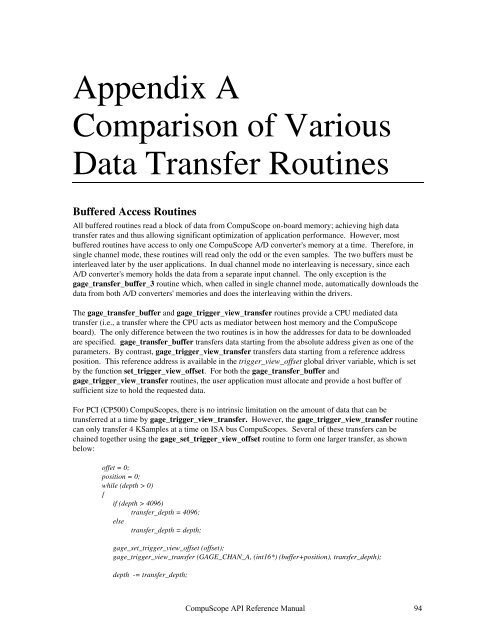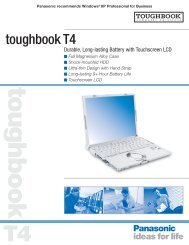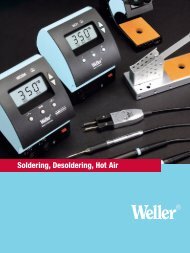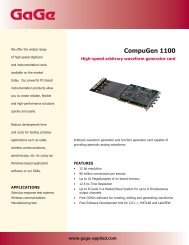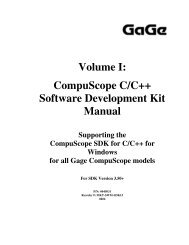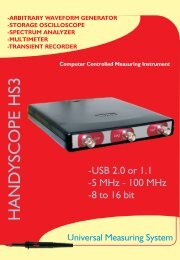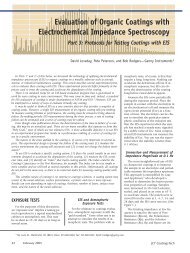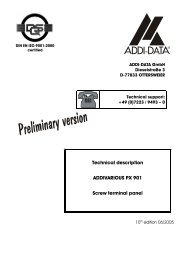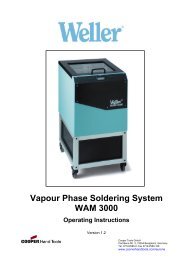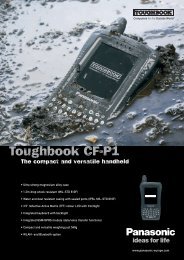CompuScope SDK Manua.. - Egmont Instruments
CompuScope SDK Manua.. - Egmont Instruments
CompuScope SDK Manua.. - Egmont Instruments
Create successful ePaper yourself
Turn your PDF publications into a flip-book with our unique Google optimized e-Paper software.
Appendix A<br />
Comparison of Various<br />
Data Transfer Routines<br />
Buffered Access Routines<br />
All buffered routines read a block of data from <strong>CompuScope</strong> on-board memory; achieving high data<br />
transfer rates and thus allowing significant optimization of application performance. However, most<br />
buffered routines have access to only one <strong>CompuScope</strong> A/D converter's memory at a time. Therefore, in<br />
single channel mode, these routines will read only the odd or the even samples. The two buffers must be<br />
interleaved later by the user applications. In dual channel mode no interleaving is necessary, since each<br />
A/D converter's memory holds the data from a separate input channel. The only exception is the<br />
gage_transfer_buffer_3 routine which, when called in single channel mode, automatically downloads the<br />
data from both A/D converters' memories and does the interleaving within the drivers.<br />
The gage_transfer_buffer and gage_trigger_view_transfer routines provide a CPU mediated data<br />
transfer (i.e., a transfer where the CPU acts as mediator between host memory and the <strong>CompuScope</strong><br />
board). The only difference between the two routines is in how the addresses for data to be downloaded<br />
are specified. gage_transfer_buffer transfers data starting from the absolute address given as one of the<br />
parameters. By contrast, gage_trigger_view_transfer transfers data starting from a reference address<br />
position. This reference address is available in the trigger_view_offset global driver variable, which is set<br />
by the function set_trigger_view_offset. For both the gage_transfer_buffer and<br />
gage_trigger_view_transfer routines, the user application must allocate and provide a host buffer of<br />
sufficient size to hold the requested data.<br />
For PCI (CP500) <strong>CompuScope</strong>s, there is no intrinsic limitation on the amount of data that can be<br />
transferred at a time by gage_trigger_view_transfer. However, the gage_trigger_view_transfer routine<br />
can only transfer 4 KSamples at a time on ISA bus <strong>CompuScope</strong>s. Several of these transfers can be<br />
chained together using the gage_set_trigger_view_offset routine to form one larger transfer, as shown<br />
below:<br />
offet = 0;<br />
position = 0;<br />
while (depth > 0)<br />
{<br />
if (depth > 4096)<br />
transfer_depth = 4096;<br />
else<br />
transfer_depth = depth;<br />
gage_set_trigger_view_offset (offset);<br />
gage_trigger_view_transfer (GAGE_CHAN_A, (int16*) (buffer+position), transfer_depth);<br />
depth -= transfer_depth;<br />
<strong>CompuScope</strong> API Reference <strong>Manua</strong>l 94


